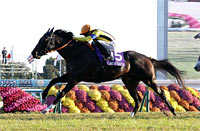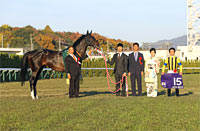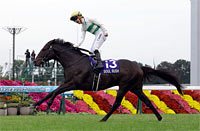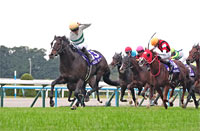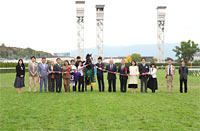Mile Championship (G1) - Data Analysis
Milers to battle for supremacy at Hanshin Racecourse in the autumn season
The Mile Championship was held at Hanshin Racecourse in 2020 and 2021. Both races were won by race favorite Gran Alegria, who also received the JRA Award for Best Sprinter or Miler in the two consecutive years. This year’s mile champion decider will again be held at Hanshin Racecourse. Let’s now look for some trends in this race based on results over the last 10 years.
Watch favoritism in previous race
Looking at performances by runners over the last 10 years in terms of favoritism, we find that 25 of the 30 Top 3 finishers were backed as 5th favorite or higher. Runners backed as 10th favorite or lower produced zero Top 3 finishers, while only one runner backed as 6th favorite or lower finished in the Top 2: 2014 winner Danon Shark. In other words, the probability of dark horses finishing in the Top 2 of this race appears to be considerably low. [Table 1]
[Table 1] Performance by favoritism (last 10 years)
| Favoritism |
Performance
[1st-2nd-3rd-4th or lower] |
Win ratio |
Top 2 ratio |
Top 3 ratio |
| 1st favorite |
2-2-2-4 |
20.0% |
40.0% |
60.0% |
| 2nd favorite |
1-4-0-5 |
10.0% |
50.0% |
50.0% |
| 3rd favorite |
2-4-0-4 |
20.0% |
60.0% |
60.0% |
| 4th favorite |
3-0-1-6 |
30.0% |
30.0% |
40.0% |
| 5th favorite |
1-0-3-6 |
10.0% |
10.0% |
40.0% |
| 6th-9th favorite |
1-0-4-35 |
2.5% |
2.5% |
12.5% |
| 10th favorite or lower |
0-0-0-85 |
0% |
0% |
0% |
Looking at performances by runners in terms of favoritism in their previous race, we find that 28 of the 30 Top 3 finishers over the last 10 years had been backed as 5th favorite or higher in their previous race. In addition, the five Top 3 finishers that were backed as 6th favorite or lower in the Mile Championship had also been backed as 5th favorite or higher in their previous race. Based on the historical data, therefore, it would seem a good idea to lower our expectations of runners that are backed as 6th favorite or lower in the Mile Championship and had the same favoritism in their previous race. [Table 2]
[Table 2] Performance by favoritism in previous race (last 10 years)
Favoritism in
previous race |
Performance
[1st-2nd-3rd-4th or lower] |
Win ratio |
Top 2 ratio |
Top 3 ratio |
| 1st favorite |
3-3-2-21 |
10.3% |
20.7% |
27.6% |
| 2nd favorite |
4-2-4-15 |
16.0% |
24.0% |
40.0% |
| 3rd favorite |
2-2-0-18 |
9.1% |
18.2% |
18.2% |
| 4th favorite |
0-3-1-18 |
0% |
13.6% |
18.2% |
| 5th favorite |
0-0-2-12 |
0% |
0% |
14.3% |
| 6th-9th favorite |
0-0-1-29 |
0% |
0% |
3.3% |
| 10th favorite or lower |
1-0-0-32 |
3.0% |
3.0% |
3.0% |
Only horses aged five or below have entered the Top 3 in recent years
Of the 30 Top 3 finishers over the last 10 years, 28 were horses aged 5 or below, while none of the horses aged 7 or above finished in the Top 3. The last 6-year-old to deliver a strong performance was second-place finisher Fiero in 2015. If trends in recent years are anything to go by, we should view this race as a contest of 3-year-olds to 5-year-olds. [Table 3]
[Table 3] Performance by age (last 10 years)
| Age |
Performance
[1st-2nd-3rd-4th or lower] |
Win ratio |
Top 2 ratio |
Top 3 ratio |
| 3 |
2-1-2-30 |
5.7% |
8.6% |
14.3% |
| 4 |
4-5-4-24 |
10.8% |
24.3% |
35.1% |
| 5 |
3-3-4-52 |
4.8% |
9.7% |
16.1% |
| 6 |
1-1-0-22 |
4.2% |
8.3% |
8.3% |
| 7 or above |
0-0-0-17 |
0% |
0% |
0% |
Runners that contested a G1 race last time out or come from the Mainichi Okan or Fuji Stakes perform well
Looking at performances by runners over the last 10 years in terms of their previous race (analyzing previous races from which five or more runners moved on to the Mile Championship), we find that runners that had performed well in a JRA G1 race such as the Tenno Sho (Autumn) or the Yasuda Kinen last time out achieved relatively high success ratios. Among recent winners, Stelvio (2018) and Indy Champ (2019) both came from the Mainichi Okan. In addition, runners coming from the Fuji Stakes, a major prep race, produced two winners and the highest number (seven) of Top 3 finishers. On the other hand, we should keep in mind that runners coming from the Swan Stakes have produced four runners-up but zero winners. [Table 4]
[Table 4] Performance by previous race (last 10 years)
| Previous race |
Performance
[1st-2nd-3rd-4th or lower] |
Win ratio |
Top 2 ratio |
Top 3 ratio |
| Fuji Stakes |
2-3-2-43 |
4.0% |
10.0% |
14.0% |
| Mainichi Okan |
2-1-2-19 |
8.3% |
12.5% |
20.8% |
| Tenno Sho (Autumn) |
2-1-2-7 |
16.7% |
25.0% |
41.7% |
| Sprinters Stakes |
2-0-0-6 |
25.0% |
25.0% |
25.0% |
| Yasuda Kinen |
1-1-0-4 |
16.7% |
33.3% |
33.3% |
| Kyoto Daishoten |
1-0-0-1 |
50.0% |
50.0% |
50.0% |
| Swan Stakes |
0-4-2-33 |
0% |
10.3% |
15.4% |
| Fuchu Himba Stakes |
0-0-1-8 |
0% |
0% |
11.1% |
| Sapporo Kinen |
0-0-1-0 |
0% |
0% |
100% |
Note: Only includes races contested by runners that finished in the Top 3.
Previous success in G1 races speaks volumes
Of the 30 Top 3 finishers over the last 10 years, 25 had experience of finishing in the Top 3 of JRA G1 race. Among this group, runners that had finished in the Top 3 of the Yasuda Kinen of the same year achieved performance of [4-3-1-9] (Top 3 ratio of 47.1%), with nearly half turning in favorable performance. In addition, runners that had finished in the Top 3 of the year-earlier Mile Championship delivered performance of [2-4-1-14] (Top 3 ratio of 33.3%), and a total of seven runners achieved consecutive Top 3 finishes in the race. We should therefore focus our attention on runners that match these profiles. [Table 5]
[Table 5] Performance by experience of finishing in the Top 3 of a JRA G1 race (last 10 years)
| Experience |
Performance
[1st-2nd-3rd-4th or lower] |
Win ratio |
Top 2 ratio |
Top 3 ratio |
| Yes |
10-8-7-79 |
9.6% |
17.3% |
24.0% |
| No |
0-2-3-66 |
0% |
2.8% |
7.0% |
Seek out the winner!
Runners that took a break over the summer have notched seven consecutive victories
The seven winners since 2015 had all won a graded race in the spring season of the same year. Another shared feature among these runners is that they did not enter any races in the period from July to September of the same year. In other words, runners that triumphed in a graded race in the spring season and took a break over the summer could be likely win contenders. [Table 6]
[Table 6] Winners’ victories in a graded race held during the spring season of the same year, and last two outings (last seven years)
| Year |
Winner |
Victory in graded race
held during spring season
of same year |
Last race |
Second to last race |
| 2015 |
Maurice |
Lord Derby Challenge
Trophy, Yasuda Kinen |
Yasuda Kinen (June) |
Lord Derby Challenge Trophy
(April) |
| 2016 |
Mikki Isle |
Hankyu Hai |
Sprinters Stakes (October) |
Takamatsunomiya Kinen
(March) |
| 2017 |
Persian Knight |
Arlington Cup |
Fuji Stakes (October) |
Tokyo Yushun
(Japanese Derby) (May) |
| 2018 |
Stelvio |
Spring Stakes |
Mainichi Okan (October) |
Tokyo Yushun
(Japanese Derby) (May) |
| 2019 |
Indy Champ |
Tokyo Shimbun Hai,
Yasuda Kinen |
Mainichi Okan (October) |
Yasuda Kinen (June) |
| 2020 |
Gran Alegria |
Yasuda Kinen |
Sprinters Stakes(October) |
Yasuda Kinen (June) |
| 2021 |
Gran Alegria |
Victoria Mile |
Tenno Sho (Autumn)
(October) |
Yasuda Kinen (June) |
(Maya Takanami)
|














